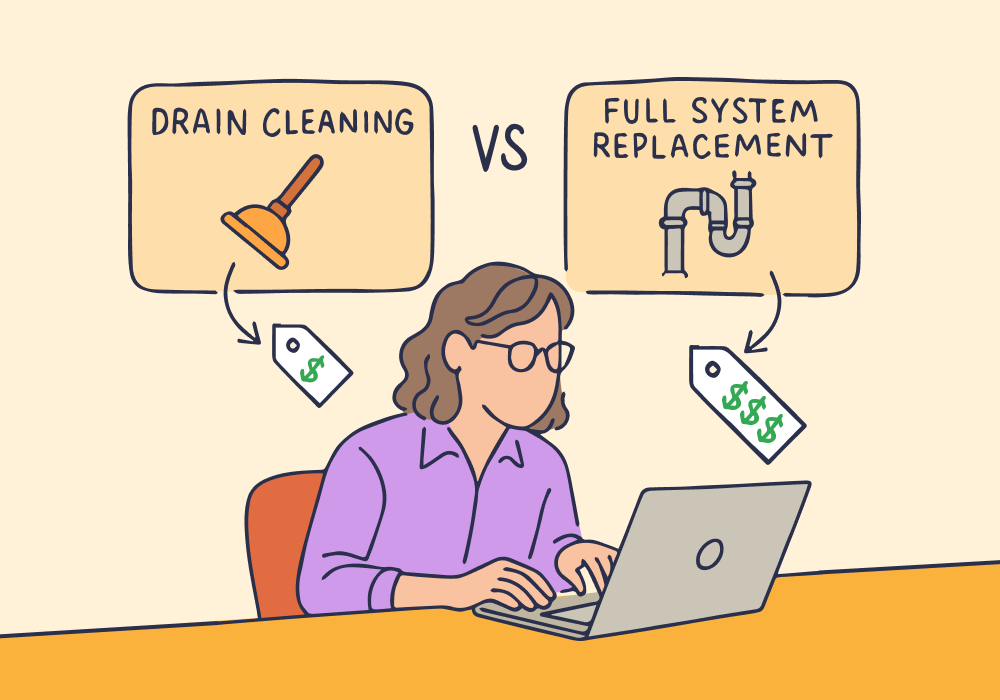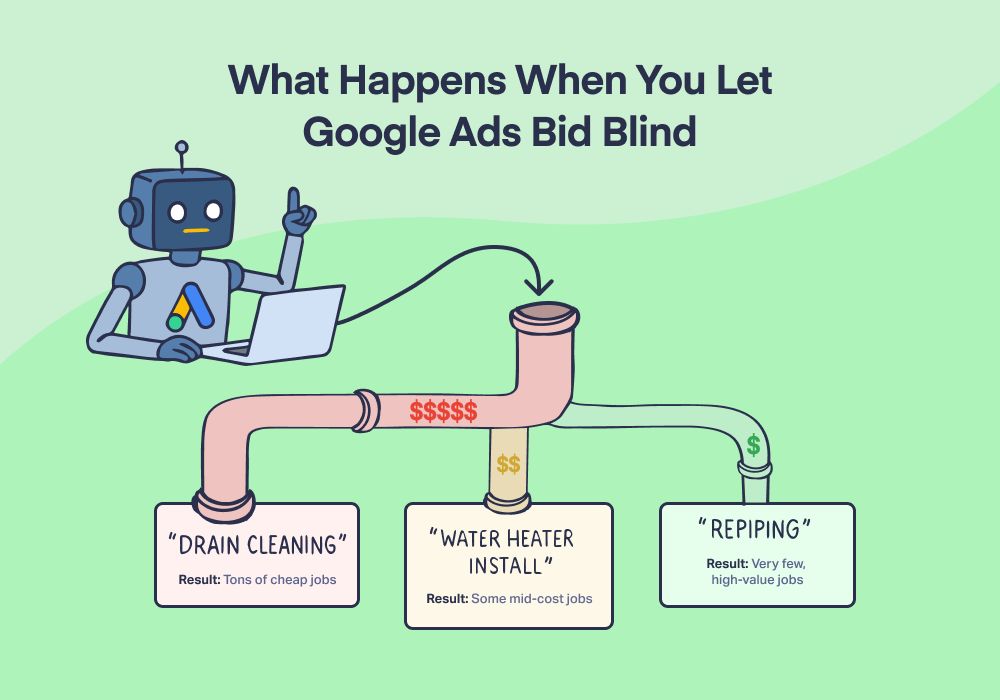
Most marketers optimize their campaigns as if all conversions are equal. The problem is: they aren’t.
It’s like going fishing and bragging about catching 20 minnows instead of five tuna. Sure, you caught more—but is that going to feed your family?
Hardly.
When you treat every lead the same, ad platforms learn to chase easy bites instead of big wins. High-value services get overlooked while low-value leads swarm the net.
This article shows how to change that—by tracking what each lead is for, valuing it by product or service, and teaching your ad platforms to fish for tuna, not minnows.
The Hidden Leak: When Algorithms Chase the Wrong Win
The problem is ad platforms only chase what you tell them to. If you aren’t giving them the data they need to know which leads matter and which don’t, then they’ll treat them all the same.
Let’s see what that looks like.
A plumbing company spends $8,000 on ads and generates 100 leads. On paper, it’s a success—$80 cost per lead, healthy volume, lots of “wins.”
But when they start looking at each lead by the service they requested, a different picture emerges:
| Service | Leads | Ad Spend | Avg Job Value | Est. Revenue | ROAS |
| Drain Cleaning | 70 | $5,600 | $150 | $10,500 | 1.9× |
| Repiping | 5 | $800 | $8,000 | $40,000 | 50× |
| Water Heater Install | 25 | $1,600 | $1,200 | $30,000 | 18.7× |
The algorithm did exactly what it was told: chase cheap conversions. The problem? The campaign was optimized for lead count, not value.
Google’s Smart Bidding saw “70 conversions” and thought, let’s get more of those. Meanwhile, the high-revenue services—repiping and water heaters—barely got any funding.
This is how marketers end up with “successful” campaigns that don’t grow the business.
The Fix: Track Service Intent → Assign Value → Feed It Back
The most reliable way to lift ROAS isn’t more budget or better ads. It’s better feedback.
Google Ads Product Liason Ginny Marvin made it clear that PPC marketers will thrive by, "giving Google the understanding of what a good lead is for your business.”
Here’s the repeatable system agencies and marketers use to make automation smarter:
1. Capture service intent on every lead.
- Every call, form, or chat reveals what the lead actually wants.
- WhatConverts automatically captures that context—“Drain Cleaning,” “Repiping,” “Water Heater”—and ties it to the source, campaign, and keyword.
2. Assign realistic values to each service.
- Use your average sale or revenue per service to define value.
- Example: Drain Cleaning = $150, Repiping = $8,000, Water Heater = $1,200.
- Now, every lead carries a dollar value, not just a count.
3. Analyze campaign performance by service.
- Reporting by service reveals what’s driving meaningful business, not just volume.
- You’ll quickly see which campaigns fill the pipeline with cheap leads and which actually drive growth.
4. Feed those values back into your ad platforms.
- WhatConverts automatically syncs conversion values to Google Ads and Meta.
- Smart Bidding and Advantage+ stop guessing—they learn which conversions are worth more and optimize for them.
5. Reallocate spend based on revenue, not gut feeling.
- Once your data reflects real-world value, you can confidently shift budget toward high-ROI services and let automation compound those results.
When every lead is tagged, valued, and synced back to your platforms, optimization becomes self-correcting.
Why This Works with Smart Bidding and Meta Ads
Automation is powerful, but it’s blind without context.
Smart Bidding and Meta’s Advantage+ campaigns thrive on feedback loops. When they only receive “conversion = yes/no,” they optimize for the easiest, cheapest conversions available.
But when you start passing conversion values, the system reorients around revenue:
- Google optimizes bids to maximize total conversion value, not count.
- Meta’s algorithm adjusts targeting and creative delivery toward audiences that drive higher-value leads.
- Both platforms stop over-funding low-value campaigns and start rewarding what actually pays off.
The secret isn’t fighting automation—it’s teaching it what a valuable lead looks like.
Proof: A 42% Lift in Patients for an Ophthalmology Clinic
A multi-location ophthalmology clinic faced the same problem.
Their campaigns looked great on paper: strong lead volume, efficient CPL, solid traffic. But most of their conversions were for $140 eye exams—not $2,000 procedures.
Using WhatConverts, the clinic:
- Captured service intent on every lead (eye exam, LASIK, cataract surgery).
- Assigned values to each procedure based on average revenue.
- Synced those values back to Google Ads and Meta through WhatConverts.
In three months, they saw:
- 42% increase in new patients
- 5% lift in conversion rate
- Clear insight into which campaigns generated high-value procedures
The budget didn’t increase—the data got smarter.
Read More: 42% More Patients with Value-Driven PPC Strategy [Case Study]
WhatConverts Makes It Simple
Implementing this system doesn’t require custom integrations or spreadsheets. WhatConverts automates every step of the process.
- Lead Tracking: Capture every call, form, and chat with complete context—source, keyword, and the product or service mentioned.
- Lead Manager and Reporting: Tag, value, and filter leads by service to reveal which ones actually drive revenue.
- Campaign Optimizer: Push those service-level conversion values directly to Google Ads and Meta, giving Smart Bidding and Advantage+ the clarity they need to optimize for profit.
With WhatConverts, marketers move beyond “we generated 100 leads” to “we generated $70,000 in revenue potential—and we know which ads did it.”
That’s the data-driven proof that builds trust with clients and leadership alike.
The Bigger Picture: From Leads to Revenue
Optimizing by product or service isn’t just a reporting improvement—it’s a strategic advantage.
When you understand which services produce the most value, you can:
- Double down on the campaigns that drive profit.
- Stop wasting spend on low-value lead sources.
- Align marketing, sales, and leadership around shared revenue goals.
Every new lead makes your campaigns smarter, and every optimization adds another layer of precision. That’s how top-performing marketers scale efficiently, even when budgets tighten.
The Bottom Line
If you’re stuck optimizing for lead count, you’re training your ad platforms to chase the wrong goal.
Shift your focus to service-level performance and let automation work for you—not against you.
See which services your budget is really buying—and what they’re worth. Start a 14-day WhatConverts trial or book a demo today.
Get a FREE presentation of WhatConverts
One of our marketing experts will give you a full presentation of how WhatConverts can help you grow your business.
Schedule a Demo
Grow your business with WhatConverts









